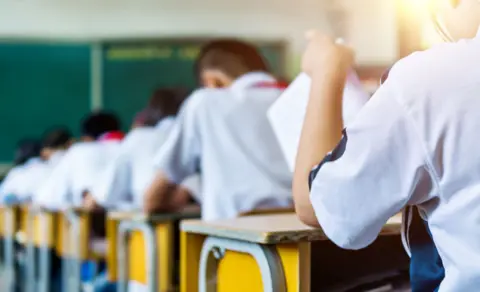
 Getty Images
Getty Images
The maths contest results prompted a nationwide debate about China's schools and academic pathways
A 17-year-old girl in China hailed as a genius in a mathematics contest cheated, competition organisers have said - ending months of scepticism over her stellar results.
Jiang Ping, a fashion design student from a rural town in Jiangsu province, made headlines in June when she came 12th in the qualifiers of an international maths contest run by Chinese e-commerce giant Alibaba.
She was the first finalist since the competition began in 2018 to have come from a lowly vocational school, Chinese media reported. The vast majority of the 800 finalists came from elite universities.
Jiang's results turned her into an overnight sensation, and she was labelled a "prodigy" in the press and on social media.
Under China's notoriously cut-throat education system, academic excellence is lauded. Many people online were encouraged by Jiang's results, seeing them as proof that students from vocational institutes could still excel academically.
However, as doubt surrounding her abilities snowballed, competition organisers said last Sunday that Jiang had violated competition rules in the preliminary round, by receiving help from her teacher, who was also a contestant himself.
“This has exposed problems like inadequacies in the competition format and the lack of rigour in supervision. We sincerely apologise,” organisers said in a statement.
According to the final results announced on Sunday, neither Jiang nor her teacher was among 86 winners in the competition.
The rise of a maths sensation
The annual mathematics contest is open to contestants from institutions worldwide and hosted by Damo Academy, Alibaba’s research institute.
This year, Jiang, a student at Jiangsu Lianshui Secondary Vocational School, outperformed other finalists from some of the world’s most prestigious institutions — including Peking University, the Massachusetts Institute of Technology, and the University of Oxford.
She had chosen to study at the vocational school both because she was interested in fashion design, and because her sister and friends were there, said local media outlets.
Jiang's results and unconventional educational background soon grabbed nationwide attention. Her story was featured in a video produced by Damo Academy and she was interviewed by news outlets across the country.
“Learning maths is bumpy, but every time I solve the problems I feel quite happy,” she told the state-run People’s Daily. “No matter what the future holds, I will keep learning.”
Jiang’s teacher, Wang Runqiu, was also thrust into the spotlight, hailed as an educator who noticed and encouraged her passion for maths. Speaking to the media, he described her as an attentive student who had learnt advanced mathematics herself.
"I have encountered many setbacks in the process of learning maths,” he said. “So, I want to do everything I can to help my students and let them know that there are other possibilities in the future.”
But along with an outpouring of praise for Jiang and her teacher, the student’s story also sparked a discussion about whether China’s education system did enough to support gifted students in less academic pathways - especially those who may not have received similar recognition by their teachers.
China's education system focuses much of its resources on those taking the "Gaokao" - the notoriously difficult exam that students need to take in order to get into university. Those in vocational schools had long faced restrictions in taking the gaokao and enrolling in regular universities, until an education reform in 2022 offered vocational school students an alternative university entrance exam.
An earlier op-ed in state-news media outlet Xinhua said that Jiang's results “hint[ed] at an awkward truth: even youths as talented as her may be easily buried without good education credentials”.
'She was not the mastermind'
But as Jiang’s fame burgeoned, criticism and scepticism surrounding her skills also started to bubble.
In June, dozens of other finalists published a joint letter they wrote to the competition organising committee demanding an investigation into Jiang. They also called for her answers to the preliminary test questions to be made public.
The finalists alleged that Jiang had made “several apparent writing mistakes” in an online video and that she “seemed unfamiliar with these mathematical expressions and symbols”.
While the preliminary round of the competition allowed participants to use programming software, the final round was a closed-book exam. The results of the finals, which were initially set to be released in August, were postponed for several months.
When the results were finally made public on Sunday, Jiang was not among the 86 winners of the final round.
Her school also confirmed in a statement on Sunday that Jiang had been helped by her teacher Wang, and that Wang had been given a warning and disqualified from teachers’ awards for the year. The statement also called for leniency and protection for the teenager.
Attempts by the BBC to contact Jiang's family were unsuccessful. A social media account once used by her mother is now defunct, and a phone number linked to her father has been deactivated. Multiple phone calls by the BBC to Jiang's school went unanswered, and a village official declined to discuss Jiang when contacted by the BBC.
While Sunday’s revelation unleashed a wave of criticism of Jiang and her teacher, many social media users also spoke up for the teenager, arguing the bigger responsibility lay with her school and teacher.
“Jiang Ping is not innocent, that’s without question. But who are the worst parties in this?” reads a post on Weibo. “The adults brought this child along to do a bad deed, and let her suffer all the consequences.”
“Even if the whole thing was faked, Jiang Ping was not the mastermind behind it,” another wrote on Weibo. “She should not be burned at the stake.”

 1 month ago
26
1 month ago
26















 English (US) ·
English (US) ·